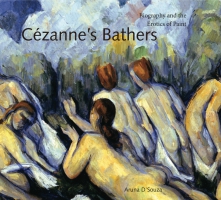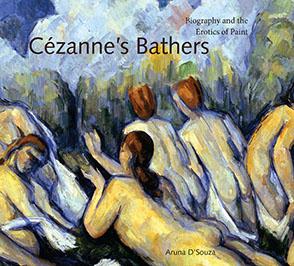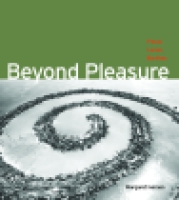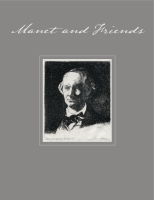Cézanne's Bathers
Biography and the Erotics of Paint
Aruna D’Souza
“An astute and original analysis of Cézanne’s key canvases, the Bathers, and through them, of the equally central issue in Cézanne scholarship, namely, the erotic dimension of his vision . . . a stimulating, truly provocative study.”
- Description
- Reviews
- Bio
- Table of Contents
- Sample Chapters
- Subjects
Cézanne’s Bathers: Biography and the Erotics of Paint proposes a new way of reading Cézanne’s biography not simply as a form of myth-making but also as a form of art criticism; at the same time, it proposes a reading of Cézanne’s images of bathers that accounts for their strangenesses and for the pleasures they produce. It is a book that is fiercely engaged with arguments about these paintings that have come before, mining the writings of figures such as Meyer Schapiro, Tamar Garb, and T. J. Clark to discover a new way of looking at these strange works.
“An astute and original analysis of Cézanne’s key canvases, the Bathers, and through them, of the equally central issue in Cézanne scholarship, namely, the erotic dimension of his vision . . . a stimulating, truly provocative study.”
“For the lay reader, Cézanne’s Bathers can be challenging at points, but it’s a rewarding look at how art history gets made and how a careful sifting through the available evidence leads to the revelation of new meanings.”
Aruna D'Souza is Assistant Professor of Art History at Binghamton University, State University of New York. She is the editor of Self and History: A Tribute to Linda Nochlin (2000) and The Invisible Flâneuse? Gender, Public Space, and Visual Culture in Nineteenth-Century Paris (2006).
Contents
List of Illustrations
Acknowledgments
Introduction: Modernism’s Two Cézannes
1. A Biography of Failure
2. Cézanne’s Bathers and the Erotics of Paint
3. Baigneurs/Baigneuses: Making a Difference
4. Matisse’s Doubt/Doubting Matisse
Notes
Index
Introduction: Modernism’s Two Cézannes
We have inherited, after over a century of commentary on his art, not one but two Cézannes: two portraits of the man that seem starkly contradictory but are, in a sense, intimately related. Witness the telling photographs taken by Cézanne’s admirers near the end of his life. Ker Xavier Roussel’s picture of Cézanne painting at Les Lauves in 1906 shows him spry, his brush poised, ready to make a carefully considered mark on a canvas placed perpendicular to the camera lens, its top tilted precariously forward to mitigate against the glare of the harsh Mediterranean sunlight (fig. 1). Cézanne’s face is in profil perdu, yet we can still make out an expression of fierce concentration as he studies his motif. His body is tensed, ready for action: he is the embodiment of vital creativity. One of Émile Bernard’s photos of his mentor, taken during his second trip to Aix in 1905, repeats this image of masculine power: Cézanne, though not painting, stands near the same site at Les Lauves, one of his favorite working spots (fig. 2). His figure fills the frame of the image. He looks larger than life and absolutely self-contained—even his hands are folded in front of him, bounded by the monolithic contour of his body, not unlike Rodin’s stele-like portrait of Balzac in all his virile glory. Cézanne’s face is half-shadowed, but despite this his gaze seems focused, sure, as he looks directly at the photographer. His hat—that symbol of sartorial splendor and metonymic substitution for bourgeois, masculine authority—contrasts sharply with the white of the sky.
Compare these photos to Bernard’s other, more famous picture of Cézanne sitting in front of his celebrated and vexing Large Bathers, now in the Barnes collection (fig. 3, pl. IX). The picture—or, more precisely, the man depicted therein—is no longer marked by the assuredness of those images discussed above. One can imagine the scene: Bernard having to cajole the reclusive painter to pose with his painting, then placing him seated just so in front of it. Cézanne’s shy pride and discomfort registers, I think, in his stately carriage. Sitting where he is, with the painting as a backdrop, it is hard not to read him as the generative source of the image behind him, as its creative font; the figures surround him, as if they are the Muses honoring his creative power.
Yet just as Bernard’s writings by this point in time make clear that he was becoming less and less convinced of his teacher’s ability to deal with the genre of the female nude so, too, does the photograph present Cézanne not as the unequivocal master of his painting but as in some senses dominated by it, broken by its ambition, inadequate to its conception. The painting itself, in its half-finished state, has not yet achieved the full strangeness of its effects—the figures still convey some degree of anatomical truth, the surface is still thinly painted, the color still retains a relative clarity (as far as can be registered in this black-and-white photograph). And yet even this early state suggests something of what the finished canvas would possess: stylized and distorted bodies, clotted, scumbled skins of paint, muddied and overworked color, eccentricities of scale and composition. In other words, a thoroughly unconventional approach to painting the female form, even by avant-garde standards. In the process of reworking the painting, Cézanne would continue his reinvention of the category of the nude, a project that had engaged him since his earliest forays into the theme in the 1870s. He would recast its pleasures in a thoroughly modern way, as an erotics of paint: that is to say, he would harness the materiality of the medium to take the place of narrative fantasies of sexual possession or even of the representation of believable bodies as such in communicating fleshly pleasures. Those puzzling qualities that would characterize the final work and that marked his work on the theme of bathers—those gaucheries, as they were termed by the painter’s contemporaries, the signs, in other words, of a naïve and awkward (but also sincere and authentic) hand—were in fact the terms of Cézanne’s new language of the erotic, even though they were only rarely or, more precisely, only obliquely understood as such by critics who most often scratched their heads at Cézanne’s strange and troubling images.
In the photograph, Cézanne is both overshadowed by the painting behind him and occludes a full view of it: as such, it stands as an appropriate metaphor for the way this artist’s unconventional approach to painting has often structured his biographical portrait and, simultaneously, for the way his mythic biography has circumscribed interpretations of his painting. Bernard’s difficulty in understanding Cézanne’s approach to the nude determined his view of the man seated before him in the studio, not simply in his critical writings, as we will see in the coming pages, but also in this portrait. No longer the active, vigorous, virile presence seen in Roussel’s photograph, no longer the solid, columnar, powerful, and strong-willed presence of the first of Bernard’s pictures, Cézanne is here transformed into their opposite: now indoors, surrounded by his naked figures, his head is bare and vulnerable, his legs are crossed and his hands are clenched in his lap, his body is compacted and compressed. He no longer dominates the frame of the photograph but seems, rather, to shrink in front of the canvas that forms its backdrop. Whereas Cézanne in the landscape, in nature, was the epitome of potent masculine genius, Cézanne in his studio, in front of this painting of baigneuses, is the image of manhood shrunken, shriveled. At the same time, it was precisely Cézanne’s strange reputation, in wide circulation at the turn of the century, as a recluse, a misanthropic hermit, an eccentric, and—most importantly—as an “impotent artist” who was inadequate (physically and psychically) to achieve his artistic goals, that led Bernard to understand his bathers, the most challenging paintings in his oeuvre, as something akin to failures.
It was no coincidence, I think, that the photographs of Cézanne that seem to embody a certain masterful, vigorous persona were taken outdoors, often depicting him in the process of painting the landscape, and that this other view of Cézanne—melancholic, diminished—was constructed in the studio, in relation to his bathers. Cézanne’s strength as an artist and innovator was most often—even exclusively—attributed by his turn-of-the-century critics to his mastery of the genres of landscape and still life: in relation, that is, to a practice rooted in optical effects, truth to nature, and an almost monastic search for beauty. Not only were his bathers hard to reconcile to conventional expectations of the erotic nude, but they were difficult to align with this idea of visual veracity, which was understood as the most important aspect of Cézanne’s artistic approach, for these odd paintings of nudes in the landscape were the product of an insular studio practice, derived not from the external world but from the mind’s eye. They seemed utterly incompatible with those qualities, that search for an authentic and sincere translation of the natural world, that most critics of the 1890s and early 1900s valued most about Cézanne’s work.
Hence our double inheritance, the two Cézannes: both the virile “father of modern art” and an impotent genius, both the painter who was transforming the terrain of advanced painting in the twentieth century and an artist whose work was marked by inadequacies and gaucheries, both the celebrated recorder of the most subtle optical effects of the sensation of nature and the disturbing (or, as some thought, disturbed) painter of deformed female flesh. Bernard’s photo at once responds to these portraits of Cézanne that were being articulated, in full contrariness, in the years around the turn of the century and takes its own part in constructing Cézanne as such a contradiction. This insistence on two Cézannes not only structures the biography of Cézanne that emerged in these years in myriad and subtle ways—Cézanne the youthful revolutionary versus Cézanne the reactionary bourgeois, Cézanne the fearless rebel versus Cézanne the fearful, fragile hermit, Cézanne the genius versus Cézanne the doubter—but also the treatment of his oeuvre, so that his landscapes, still lifes, portraits, and genre scenes have tended to be quarantined from his treatment of the nude, a subject that occupied him throughout his career, from his first brushstrokes to his last.
This book is an attempt not to reconcile the two pictures of Cézanne and his oeuvre but to understand the stakes of the distinctions between them. In one sense, this volume is an essay on Cézanne’s biography—that range of writings, which took the form of fiction, art criticism, and memoirs of personal encounters with the famous (or infamous) painter, that were written just before and after his death in 1907 by figures such as Émile Bernard, Maurice Denis, Ambroise Vollard, Joachim Gasquet, Gustave Geoffroy, Émile Zola, and many others, major and minor. But more crucially, this book is a reflection on his paintings of the male and female nude, his so-called bathers. For it is from Cézanne’s biography, rife with images of sexual anxiety and impotence, of failure and doubt, that one may glean an interpretation of the bathers that was emerging in the 1890s and 1900s, an interpretation that could not, perhaps, be articulated outside of biographical terms as such. To state it plainly: my argument is that Cézanne’s bather paintings radically redefined what it meant to paint the erotic nude and that his redefinition of that genre was so mystifying to his critics that they could only understand his artistic intervention as a failure of his masculinity. Hence the apparent need to write biography in the place of art analyses. The critics’ recognition of the ways Cézanne reconceived the erotic nude was never stated outright in the many attempts to write about the bathers in the years around the turn of the century yet can be discerned everywhere through a careful reading of the various textual portraits of Cézanne that were written, even in the glancing form of the art critic, in the 1890s and 1900s.
Cézanne’s biography—meaning his biography as a literary form, as a text—is marked by its pathos: it is a particularly unexpected narrative of artistic genius, since he is repeatedly characterized an artist who has not always lived up to the lofty goals he set for his art. Rather than overflowing with images of Cézanne as a heroic figure of avant-garde assuredness—as something like a Courbet, cutting a swath through tradition and definitively reorienting the path of nineteenth-century art—the accumulation of writings that constitute his biography as it was emerging at the turn of the century often as not picture Cézanne as a fearful, paranoid man almost paralyzed with anxiety. Needless to say, this is hardly the most obvious portrait of an artist who is central to most, if not all, accounts of European modernism. The roots of this narrative of Cézanne as an impotent genius—both in romantic and later naturalist fictions of artistic endeavor as well as in a contemporary, pseudoscientific discourse around the pathology of genius—and the stakes of this picture in an analysis of the artist’s work, especially his forays into the representation of the nude, are explored in the first chapter of this volume.
In reading the early criticism of Cézanne, much of which took the form of artistic biography, it is striking the degree to which images of Cézanne’s troubled masculinity were articulated in relation to a discussion of his paintings of the nude, and simultaneously by the way the bathers sat so uneasily, in the minds of his commentators, with the rest of Cézanne’s oeuvre. This discomfort with the paintings—with their relation to Cézanne’s “other” practice of landscape, still life painting, and portraiture and with their strangeness in relation to contemporary conventions of the genre of the nude as such—is apparent in the literature up to the present moment. The second chapter investigates the history of writings on Cézanne and his bathers and the way the various accounts of these works that emerged in the second half of the twentieth century (especially those by Meyer Schapiro, Theodore Reff, Tamar Garb, and T. J. Clark) might be harnessed to bring us closer to an understanding of Cézanne’s project as one rooted in an investigation of the material qualities of paint and its potential to evoke a sensualized response. At the same time, I engage critically with these approaches to Cézanne’s oeuvre, especially in relation to the deployment of a range of psychoanalytic descriptions of the operations of desire that, in their dependence on visual metaphors, remain inadequate to explain the bathers’ haptic address. It was this materialized aspect of Cézanne’s practice—the dislocation of the signifier of the erotic from the depicted body itself to the painted mark, the manipulation of paint on the surface of the canvas—that constituted his painterly erotics.
If the writings on Cézanne’s bathers suggest something like an “erotics of paint” operating in his pictures of the nude, this is an indication that the erotic element in these works is not (as the most familiar interpretations of his oeuvre would insist) a private, traumatic, sublimated or simply repressed symbolic dimension but rather part of the paintings’ public address and a sign of the painter’s reaction to a number of prior interventions into the terms of the genre. That this engagement with the historical and contemporary stakes of the nude registered with the painter’s contemporaries is indicated by the insistent attempts at distinguishing, and separating, one type of bather painting from another: the male and female bathers, the baigneurs and baigneuses, were understood as having entirely different geneses, the former in memory and direct observation and the latter in Cézanne’s imagination, even though there was no visual justification for this belief. The implications of this segregation are entirely gendered and stem from the way Cézanne’s contemporaries interpreted his gaucheries: his failures of execution were linked in the critics’ imagination to Cézanne’s unresolved passion for his (female) models and thus were deeply problematic when encountered in his baigneurs as well. Exploring this overdetermined attempt to segregate baigneurs from baigneuses is a means of recognizing the critics’ understanding—inchoate as it often was—of Cézanne’s interventions into the representation of eroticism.
The book ends with a reading of Cézanne’s bathers that is at once thoroughly rooted in Cézanne’s contemporary moment but that also suggests the implications for a later modernist practice: that of Henri Matisse, whose writings and work are filled with references to Cézanne, especially to his imagings of the nude. It is here, perhaps, that this book makes its biggest claims: Cézanne’s shifting of the terms of the erotic to the material signifier of paint from the representational component of the bodies depicted was, I suggest, precisely understood by Matisse and thus set the terms for a certain strand of modernism’s engagement with the sensualized body. My starting point in making this argument is Matisse’s utterly stubborn misreading of Cézanne’s bather paintings, articulated in his “Notes of a Painter” of 1908, in which he insisted on substituting for the more common description of Cézanne’s bather images as lacking in bodily coherence a description that asserted their utter lack of visual or anatomical confusion. Reading against this text, one can come to understand Matisse’s words as a self-conscious, textual dissimulation of not only the erotic effects of Cézanne’s work but of Matisse’s own. Like the critics who were writing on Cézanne at the same, and who were only able to voice the strangeness of Cézanne’s erotics of paint obliquely, through the form of biography, Matisse, too, was only able to address this aspect of Cézanne’s practice in an indirect way: in terms of paint rather than words, in canvases in which the structural and material conditions of paintings do not sublimate or replace desire but produce them in defiance of the willfully distorted bodies on display.
If the existence of two Cézanne’s in criticism on the artist has proved a troubling fact for most scholars, it has also been a productive one. For that reason, this book does not set out to restore Cézanne to wholeness and unity, to reintegrate the bathers into his oeuvre, reconstructing his practice as seamless whole, or to make those pictures familiar through scholarly explication. Rather, it seeks to preserve—and, at its best moments, heighten—that radical disjuncture or discontinuity that Cézanne’s first critics found so troubling and to insist on the fundamental rupture these works effected in the history of the erotic nude. The bathers could only evoke overt disavowal by even his most sensitive observers, but against the grain of this repression emerged the terms for a new conception of painting the pleasures of the body in the twentieth century.
Also of Interest
Mailing List
Subscribe to our mailing list and be notified about new titles, journals and catalogs.






